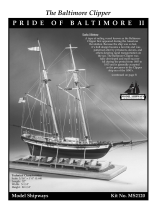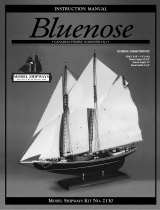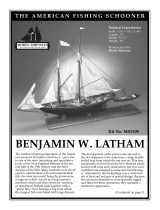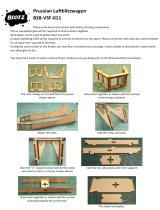Page is loading ...

The stern block and searchlight control towers
5
Smooth the searchlight
control towers (5) with
the metal file, eliminating
irregularities; the bottom of the
piece must be flat. Remember
that too much pressure can
leave marks, which may be
difficult to erase.
4
Place what was assembled
in the previous step, as
shown in the photo, and, after
applying wood glue, set block
no. 3on the assembly. Thread
it on the rods and align it with
the other two blocks.
3
Insert the second rod no. 4
in the other hole in block
no. 2and fix firmly with
fast-drying glue.
1
Place block no. 1, as shown in
the photo. Insert rod no. 4in
the hole and fix firmly with
fast-drying glue.
2
Take what was assembled in the
previous step, as shown in the
photo. After applying wood glue to
piece no. 2, set it on block no. 1.
Align the two pieces along the base.
• Wood glue
• Sandpaper (no. 800 grain)
• Metal file
• Putty
• Craft knife
• For metal: Super Glue Gel or
Two-part epoxy glue
• Metal primer
• Battleship-grey model-making
spray paint
• Model-making watercolours
(matt black and battleship grey)
• Fast-drying glue
• Tweezers
• Paint brush
Recommended tools and materials
THE STERN BLOCK
SEARCHLIGHT CONTROL TOWERS
Yamato: Step-by-step 37
Stern block no. 1
Stern block no. 2
Stern block no. 3
Round rod x 2
Searchlight control tower
(with base) x 2
Searchlight control tower
(without base) x 2
For assembling the pieces 1–3, refer to the 1:1 scale plan on page 39.

11
Where it is difficult to reach
with sandpaper, use the craft
knife, which can also be used for
modelling the edges. Take extra
care not to cut your fingers.
6
Smooth pieces no. 5with
grain no. 800 sandpaper,
taking care not to scratch the
original reliefs.
9
When the putty is
completely dry, smooth
with grain no. 800 sandpaper to
eliminate excess putty and obtain
the required surface.
10
Now prepare pieces no. 6.
Remove irregularities with
the metal file, remembering that
the bottom must be flat. Do not
use too much force. Then,
smooth pieces no. 6with grain
no. 800 sandpaper, taking care
not to scratch the original reliefs.
8
If pieces no. 5show any
irregularities, apply a thin
layer of putty over the entire
surface. As it dries, the putty
may shrink and leave hollows:
in this case, repeat the operation.
13
Now paint pieces no. 5and
no. 6. After fixing them on
cardboard with double-sided
adhesive tape, as shown in the
photo, spray metal primer evenly
from a distance of 30cm.
7
Where it is difficult to reach
with sandpaper, use the craft
knife, which can also be used for
modelling the edges. When using
the craft knife, be extra careful
not to cut your hand or your
fingers.
12
If piece no. 6shows any
irregularities, apply a thin
layer of putty over the entire
surface. As it dries, the putty may
shrink and leave hollows: in this
case, repeat the operation.When
the putty is completely dry, smooth
with grain no. 800 sandpaper to
eliminate excess putty and obtain
the required surface.
15
Spray again evenly and
change direction several
times. Be careful that the paint does
not fill in the original small reliefs.
14
When the metal primer is
completely dry, apply a thin
and uniform coat of battleship grey
model-making spray paint, keeping
the canister about 30cm away. Let
it dry thoroughly.
When using model-making spray paint, ventilate the room well and follow the
instructions on the packaging.
When using metal primer, ventilate the room well and follow the instructions
on the packaging.
Yamato: Step-by-step 38

17
Place the command bridge as
shown in the photo and use
metal glue to fix piece no. 5on the
starboard base, towards the stern.
The base of the piece must be
aligned with the edge of the base of
the command bridge; the front
must face the side of the ship.
18
Now glue piece no. 6on
the base on the other side
of the command bridge, in the
direction of the bow. The base of
the piece must be aligned with the
edge of the base of the command
bridge; the front must face the
side of the ship.
16
After attaching the no. 5and
no. 6pieces to a strip of wood
with double-sided adhesive tape, as
shown in the photo, paint the inside
of the front cavity. Mix equal parts of
battleship grey and matt black
model-making watercolours. Apply
the paint with the tip of the brush,
using a small quantity of paint to
prevent smudging.
19
Proceed as in Steps 17
and 18 and glue the
remaining pieces no. 5and
no. 6on the opposite side.
COMPLETED PIECES
Searchlight
control towers
BRIDGE
STERN BLOCK
PIECES OF THE STERN BLOCK IN 1:1 SCALE
Yamato: Step-by-step 39

25
With the craft knife,
trim off the protruding
part of the rods in stages. Rest
the blade on the flat surface of
the last block and cut lightly.
24
Finally, glue block no. 8
(5) onto block no. 7 (4).
23
Now glue block no.
7 (4) onto block no.
6(3).
20
Take the already built stern
block as shown in the photo.
Apply wood glue to block no. 4 (1)
and set it on block no. 3. Align the
pieces and press down firmly so that
the join is tight.
22
In the same way, glue block
no. 6 (3) onto block no. 5
(2), aligning it with the blocks
placed previously.
21
In the same way, glue block
no. 5 (2) onto no. 4 (1),
aligning it with the blocks below.
• Wood glue
• Sandpaper (no. 400 grain)
• Craft knife
Recommended tools and materials
THE STERN BLOCK
Stern block no. 4
Stern block no. 5
Stern block no. 6
Stern block no. 7
Stern block no. 8
For assembling the pieces 1–5, refer to the 1:1 scale plan on page 42.
The stern block
Yamato: Step-by-step 40

29
Reduce the stern block by
trimming down the outline.
As the profile of the sides will be
finished after fixing the outer
plating on the hull, excessive
reduction at this point would make
retouching necessary. It is better to
smooth the block leaving a margin
of safety. The final finishing of the
sides also includes reduction of the
step between one layer and another
of the stern block, as shown in the
diagram (right). We
therefore recommend
leaving on part of the
original darker colour
(also see the photo with
Step 36).
30
Begin work on the ends of
the stern block. With the
blade of the craft knife held at an
angle, trim lightly, avoiding deep
cuts. When using the craft knife,
be extra careful not to cut your
hand or your fingers.
26
Now cut the rod downwards
from above to reach the
previous cut and removed the loose
piece. Repeat the operation several
times, removing the rod one piece
at a time.
28
Take the hull and place the
stern block against frame
no. 18. You must get the faces of
the two pieces to stick firmly, so
that the upper profile of both
match one another. After checking
that the stern block is centred in
relation to the sides of the hull,
apply glue and fix.
32
Once the correct contour
is achieved, remove the
protruding part of the rods,
following the procedure in
Steps 25 and 26.
27
Smooth the flat surface of
the stern block with the
sandpaper. It may be easier if you
wrap the paper around a block of
wood.
31
Work on the bottom side
of the stern block,
trimming it to obtain a gradual
curve. Smooth the stern block
around the wooden rods.
34
The bottom side of the
stern block is easier to
smooth with the blade of the
craft knife held as shown in the
photo. Trim so that the joint of
the surfaces of the base make a
natural curve with the side
edges.
33
Trim the sides of the
stern block. Be careful
not to use too much force as it
is easy to cut too deeply along
the grain.
2mm
Deck side
Hull bottom side
Leave 2mm
from the top
without
smoothing
Yamato: Step-by-step 41

35
Repeat the process in
Steps 33 and 34 on the
opposite side, so that the shape
is symmetrical. Begin with an
initial rough trim, then go on to
a finer finish, trying to keep a
uniform outline on both sides
of the hull.
36
Continue until you
obtain the approximate
shape shown in the photo.
Further refinement will be
made after applying the outer
plating of the hull. Over-
trimming can be corrected
by applying putty.
COMPLETED PIECE
STERN BLOCK
1:1 SCALE REFERENCE
PLAN OF THE STERN
BLOCK PIECES
Yamato: Step-by-step 42

Base of the bridge
Base of the bridge
Base of the bridge x 2
Base of the bridge
Strakes x 10
• Fast-drying wood glue
• Metal file
• Sandpaper (no. 800 and no. 240
grain)
• Craft knife
• Pencil
• Putty
• Metal primer
• Model-making spray paint
(battleship grey)
• Wooden rods
• For metal: Super Glue Gel or
Two-part epoxy glue
Recommended tools and materials
The base of the bridge and strakes
43
When the paint is
completely dry, use metal
glue to stick piece no. 1to the
base of the bridge assembled in
Step 39, as shown in the photo. If
the base is shorter than piece no.
1, leave the same space to the right
and the left.
42
When the metal primer
is completely dry, apply
a light and uniform layer of
battleship grey model-making
spray paint, keeping the canister
about 30cm away. Give the
pieces several coats, spraying
from different directions.
41
At this point, paint the
area highlighted by the
red circle in Figure A. First,
spray metal primer evenly
within the indicated area from
a distance of 30cm. Then spray
the surfaces of both pieces.
When using metal primer, ventilate the room well and follow the
instructions on the packaging.
When using model-making spray paint, ventilate the room well and
follow the instructions on the packaging.
39
Place the other piece no. 3
in the round cut-out on the
right of piece no. 2and fix it with
metal glue.
40
Now glue piece no. 4to
the right of piece no. 3.
The upper side of pieces no. 2
and no. 4must be in line. To find
the correct alignment, use piece
no. 1as shown in the photo, but
without gluing it.
38
Place piece no. 2as shown in
the photo and insert one of
the no. 3pieces into the round
cut-out on the left. Fix it firmly
with metal glue.
37
Smooth the pieces nos. 1to
4, first with the metal file
and then sandpaper (grain no. 240)
to eliminate irregularities. To work
the flat parts it may be easier to fix
the sandpaper with double-sided
adhesive tape around a block of
wood, as shown in the photo.
THE BASE OF THE BRIDGE
A
Yamato: Step-by-step 43

49
In places difficult to reach
with the sandpaper, gently
use the craft knife, being careful
not to distort the overall shape.
44
Fill in the joints between
pieces no. 1to 4with
putty, using a wooden rod as a
spatula. Prepare the sides and the
top of the pieces no. 1to 4by
applying a thin layer of putty
over the entire surface to cover
any small imperfections.
47
Fix the strakes on the
frames. First, smooth the
sides of the frames by removing
the sharp edges and shaping the
curved contour, as shown in
Steps 48 and 49.
48
With the sanding block
made in Step 37, roughly
smooth the sides of the frames.
Work the curved parts such as
the stern and the bow very
carefully, ensuring that you do
not reduce the size of the frames
with excessive pressure.
46
Paint the parts where the
paint is damaged or
covered by putty with battleship
grey model-making spray paint.
51
Holding the strake firmly,
pencil a mark on each frame at
the point at which the top edge of
the strake passes. Then draw a mark
on the strake, corresponding to half
the thickness of the 5th frame. The
first strake will be glued from the 1st
to 5th frame.
45
When the putty is
completely dry, smooth
with grain no. 240 sandpaper to
remove the excess until you obtain
the desired surface. If the surfaces
are not perfectly smooth, repeat
Step 44. By rubbing the joins with
the tips of your fingers, you will
be able to feel the slightest
irregularity.
50
Place a strake (5) on the sides
of the bow frames nos. 1 to 5,
making the top edge align with the
groove of the 3rd, 4th and 5th frames
(Figure B). For the 1st and 2nd
frame, the correct height is where the
strake lies, the right end of which
must reach the bow block.
52
Cut the first strake at the
mark made in the previous
step; cutting all four faces with the
craft knife will make the operation
easier and more precise. The cut
must be slightly slanted, so that the
strake, once glued, forms a right
angle with the frame (Figure C).
53
Use fast-drying wood glue to
fix the strake at the level of
the points marked in Step 51.
B
Strake
Frame
5th frame
C
Strake
5th frame
VIEW FROM ABOVE
STRAKES
Yamato: Step-by-step 44

55
Cut the second strake as
you did the first strake in
Step 52.
54
The second strake will
be fixed from the 1st to
the 4th frame. Holding it on
the frame under the strake fixed
in the previous step, make a
mark corresponding to the
middle of the thickness of the
4th frame, as in Step 51.
58
The third strake should
be glued from the 1st to
the 5th frame like the first.
Following the procedure set out
in previous steps, cut, smooth
and fix with fast-drying glue.
59
Following the instructions in
Steps 54 to 57, glue the
fourth strake from the 1st to the
4th frame.
57
After smoothing the
second strake, fix it with
fast-drying glue, starting from
the point indicated in Step 54
on the 4th frame. By applying
glue to the sides of the two
strakes, as well as the frame,
you can fix it easier.
60
As you approach the bottom
of the vessel, the curve of the
side becomes more pronounced. In
this case it is better to wet the strip
with water, to make it more
flexible, and bend it, as shown in
the photo. Glue it after letting it
dry completely.
56
Now deal with the face
that butts onto the first
strake. Using the sanding block,
work the piece gently, checking
from time to time to make sure
it fits perfectly to the first strake,
as indicated by the red line in
Figure D.
61
Now glue the fifth strake
under the fourth strake
(fixed in Step 59) from the 1st to
the 5th frame.
62
Following the instructions in
Steps 50 to 61, glue the five
remaining strakes on the other side.
The first must be fixed as described
in steps from 50 to 53, from the 1st
to the 5th frame. The other four
must be glued between the 4th and
5th frame. The strakes of the two
sides must be symmetrical.
COMPLETED PIECES
BASE OF THE
BRIDGE
STRAKES
4th frame
D
Yamato: Step-by-step 45

Base of the bridge
Base of the bridge x 2
Base of the bridge
Strakes x 10
• Fast-drying glue
• Metal file
• Sandpaper (no. 800 and no. 400
grain)
• Craft knife
• Pencil
• Wood glue
• Metal primer
• Model-making spray paint
(battleship grey)
• For metal: Super Glue Gel or
Two-part epoxy glue
• Putty
Recommended tools and materials
The base of the bridge and strakes (2)
69
Repeat the operation
several times, taking
care to spray from different
directions, until the colour
matches the base of the bridge
painted earlier.
68
When the metal primer
is completely dry, lightly
spray battleship grey paint
from a distance of about 30cm
and let it dry well.
67
Now paint the part you
assembled in Step 66.
From a distance of about 30cm,
spray metal primer on the inner
edge, as shown in Figure A.
When using the metal primer, ventilate the room well and follow the
instructions on the packaging.
When using model-making spray paint, ventilate the room well and follow
the instructions on the packaging.
65
With metal glue, fix the
other piece no. 2in the
hollow at the left end.
66
Glue piece no. 3on the left
of piece no. 2, taking care to
place it as shown in the photo. Put
the base of the bridge built
previously to the upper edge of
pieces no. 1and no. 3, as shown in
the photo, but without gluing. This
assembly is the starboard side.
64
Place piece no. 1as shown in
the photo and fix a piece no.
2to the right end with metal glue.
63
Prepare the pieces nos. 1to 3
by smoothing with the metal
file and then with sandpaper (no.
400 grain). When you have
eliminated any irregularities on
the surface, smooth the flat part as
shown in the photo, using a no.
400 grain sanding block.
A
BASE OF THE BRIDGE
Yamato: Step-by-step 46

75
Adjust the shape of the
strake so it fits as well as
possible with the strake placed
previously. Thin the right end
by tilting the point of the craft
knife, as indicated in the photo.
70
When the paint is dry, put
the base of the starboard
command bridge next to the port
one built earlier, aligning and
fixing it with metal glue, as shown
in the photo. If the piece just
mounted is shorter, centre it in
relation to the long side of the
base of the bridge.
73
Spray battleship grey
model-making paint on
parts which may be discoloured,
and on the points where you have
applied glue. Let it dry
thoroughly.
74
After the first strake fixed
in Step 53, insert a new one
without gluing so that it goes from
the 5th starboard bow frame to the
9th frame. Its upper end must be
flush with the neck of the frame
itself (Figure B).
72
When the putty has
completely dried, smooth
the surface of the piece with no.
400 grain sandpaper. If necessary,
apply putty to the piece again. By
touching the surface with the tips
of your fingers, you can check for
imperfections.
77
Take the strake and cut
it at the mark. By
cutting all four faces with the
craft knife, the operation will
be easier and more precise. The
section should be slightly
slanting so, that once glued,
the strake forms a right angle
with the 5th frame (Figure C).
71
Apply putty along the join
between the two pieces.
Use the tip of a wooden rod as
a spatula. Also, apply putty where
you think necessary to cover
scratches or hollows in the pieces.
76
Place the newly finished
strake no. 4 in the
position described in Step 74,
without glue. Place it between
the 5th and 9th frames and,
holding it firmly, make a pencil
mark on it at the central point of
the thickness of the 9th frame.
78
Before gluing the strake,
check its flexibility. To
make it more flexible, it helps to
wet it with water and bend it
without using excessive force, as
shown in the photo. Then let it
dry thoroughly.
79
Fix the strake with fast-
drying wood glue in the
position shown in Step 74. Hold
the strip in position until the
glue dries.
B
Strake
Frame
C
Strake
5th
frame
VIEW FROM ABOVE
STRAKES
Yamato: Step-by-step 47

81
Cut the strake at the pencil
mark, following the same
procedure as in Step 52.
80
Glue a second strake between
the 4th and the 8th frame.
Place it on the frames just below the
one you placed in the previous step.
Then make a pencil mark at the
point which coincides with half the
thickness of the 8th frame, as in Step
51.
84
Fix the third strake with fast-
drying glue under the one
glued in the previous step, placing
it between the 5th and 9th frame.
Cut it to length, as described in
Steps 74 to 78.
85
Using the same
procedure, fix with
wood glue the fourth strake
between the 4th and 8th frame
below the strake fixed in Step
84.
83
Once the strake is finished, fix
it with wood glue. To fix it
more firmly, also apply glue to the
side of contact with the first strake.
86
Use wood glue to fix
the fifth strake between
the 5th and 9th frame, below
the strake fixed in Step 85.
82
Smooth what will be the
contact surface of the
strake, using sandpaper grain
no. 800 (for convenience wrap it
round a block of wood). Shape it
so that the second and first
strakes are tight-fitting, as
shown in Figure D.
87
Following the
instructions in Steps 74
to 86, glue the remaining five
strakes on the other side. The
first piece must be fixed as
described in Steps 74 to 75,
going from the 5th to the 9th
frame.
88
Fix a second strip
immediately below the one
fixed in Step 87, between the 4th
and the 8th frames. The last three
strakes must be fixed as follows: the
first between the 5th and 9th frame,
the second between the 4th and the
8th, and the third between the 5th
and 9th frame. The strakes must be
symmetrical on both sides.
COMPLETED PIECES
STRAKES
D
BASE OF THE
BRIDGE
Yamato: Step-by-step 48
/






